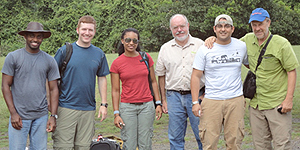by Andy Kilmer
While many of the PCP-PIRE participants toured the fossil localities in the Panama Canal and contemplated the paleoecology of mainland Panama during the Miocene, several researchers traveled to the Pearl Archipelago in the Bay of Panama to familiarize themselves with a slightly more recent system. We visited the islands because we are all interested in different aspects of the same central question: What influenced the biogeography of the islands since their split from the mainland?

David Steadman, Curator of Ornithology at FLMNH, George Angehr, Director of exhibits at the BioMuseo in Panama City, Ty Christian, a UF undergraduate, and graduate students Jorge Pino, Nicole Cannarozzi and I, traveled to the islands to study possible avenues of research and determine the logistics of island research. Over five days, we visited Isla de San José and Isla Pedro Gonzalez.
Jorge and Ty sought to survey the mammals of the islands and to obtain genetic material from the tiny brocket deer endemic to San José for analysis. Ty and Jorge collected some specimens from San José: a bat and two spiny rats. While we did see some native mammals and several introduced species, we were not able to find the local brocket deer. We hope it still lives on the island and that we can determine its affinities soon.
Personally, I am very interested in the birds of the Pearl Archipelago and hope to do additional work there in the years to come. With George and Dave’s help, I identified nearly 60 birds on our short trip. Highlights include the endemic White-fringed Antwren, three species of hummingbird and a Barn Owl (Barn Owls haven’t been recorded on San José since the 1940s).
The main reason for our trip to the island of Pedro Gonzalez was to assess the condition of a Pre-Hispanic midden previously excavated by Richard Cooke and the potential for future work. Nicole was excited by the time depth represented at the site and all of us were fascinated by the prospects of working with Richard on the site in the future. We visited his lab in Panama City after our trip to the Pearls and were shown hundreds of well-preserved bones from the site including fish, bird and mammal bones. With these remains it is possible to determine which species were utilized by prehistoric people and possibly determine the effects of colonization on the island’s ecosystem.
Overall the trip was a major success and we were able to get a better idea of what could be accomplished on the islands. Hopefully we will be traveling back to the islands soon for rigorous collecting work. We are also considering a zoological and archaeological field course on the islands. Stay tuned!
por Andy Kilmer
Mientras muchos de los integrantes del PCP-PIRE se fueron de gira a las localidades fosilíferas del Canal, y contemplaron la paleoecología de Panamá continental durante el Mioceno, varios investigadores viajamos al Archipiélago de las Perlas en la Bahía de Panamá para familiarizarnos con un sistema más reciente. Visitamos las islas porque todos estábamos interesados en los diferentes aspectos de una misma pregunta central: qué influenció la biogeografía de las islas desde que se separaron del continente?

David Steadman, Curador de Ornitología del Museo de Historia Natural de la Florida, George Angehr, Jefe de Exhibiciones del BioMuseo de Panamá, Ty Christian, estudiante de pregrado de la Universidad de la Florida, y los estudiantes de posgrado Jorge Pino, Nicole Cannarozzi y yo; viajamos a las islas para estudiar posibilidades de investigación y la logística de las islas. Por cinco días, visitamos la Isla de San José y la isla Pedro González.
Interesados en estudiar los mamíferos de las islas, Jorge y Ty trataron de obtener material genético para análisis del pequeño Mazama, endémico de San José. También colectaron algunos especímenes de San José: un murciélago y dos ratas espinosas. Aunque vimos algunos mamíferos nativos y varias especies introducidas, no pudimos localizar Mazamas. Esperamos que aún viva en la isla y que podamos determinar sus afinidades pronto.
Personalmente estoy muy interesado en las aves del Archipiélago de Las Perlas y espero realizar trabajo adicional en los próximos años. Con la ayuda de George y Dave, identifiqué cerca de 60 especies en nuestro corto viaje. Entre las especies importantes están tres especies de colibrís, el pechinegro, y una lechuza (las lechuzas no habían sido registradas en San José desde los años cuarenta).
La principal razón de nuestro viaje a la isla Pedro González fue evaluar la condición de un conchero pre-hispánico previamente excavado por Richard Cooke, y su potencial para futuros trabajos. Nicole estaba emocionada por la profundidad en el tiempo representada en este sitio y todos estábamos fascinados con los prospectos de trabajar con Richard en el futuro. Luego de nuestro primer viaje a Las Perlas, visitamos su laboratorio en Ciudad de Panamá y vimos cientos de huesos bien preservados del sitio, incluyendo huesos de peces, aves y mamíferos. Con estos restos es posible determinar cuáles especies fueron usadas por pueblos prehistóricos y posiblemente determinar los efectos de la colonización en el ecosistema de la isla.
En general, el viaje fue un gran éxito y pudimos tener una mejor idea de que puede lograrse en las islas. Con suerte estaremos viajando de regreso pronto para un trabajo de colección riguroso. También estamos considerando un curso de campo zoológico y arqueológico en las islas. Estén atentos!